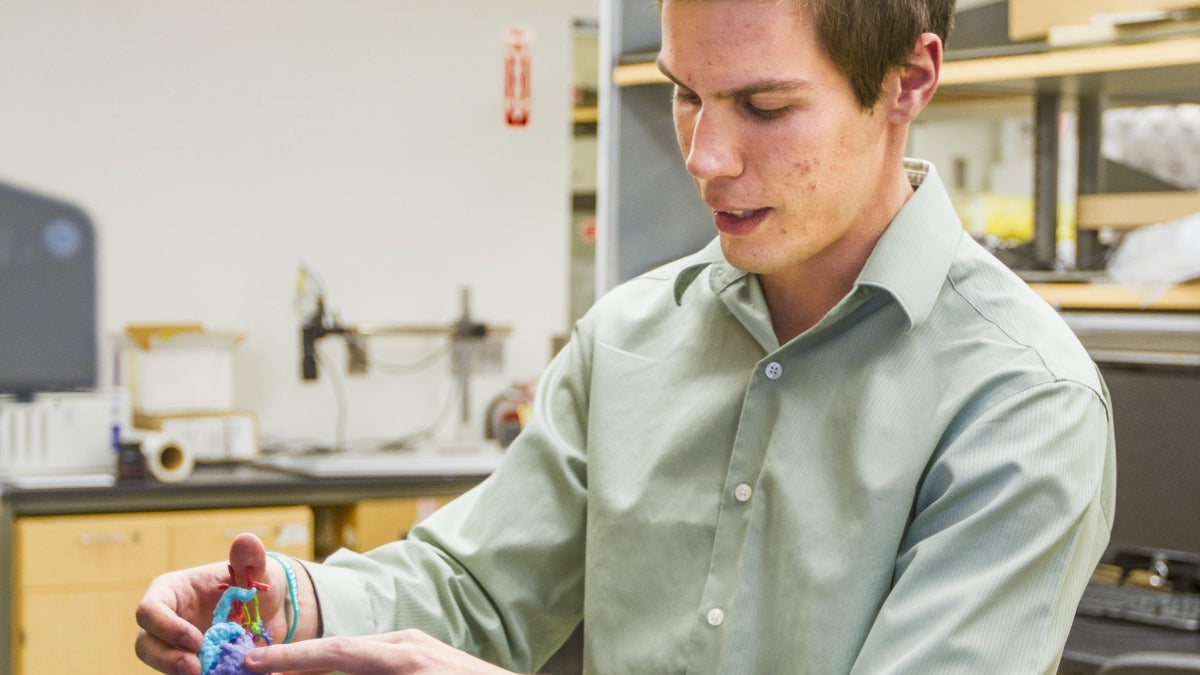The solution to a fraught moment in the first episode of the new CBS medical drama "Pure Genius" came from a real-world technology that has been advancing thanks in part to a collaboration between Phoenix Children’s Hospital and Arizona State University: 3-D printed hearts.
At least twice a week, surgeons at the hospital use the devices as they try to save lives, according to university and hospital statistics. Surgeons use the replicas to plan the best ways to fix any number of defects, before they cut into a patient.
It’s a relatively recent development. The journey to the Cardiac 3D Print Lab began in 2010 when David Frakes, an ASU engineering professor, started recruiting art majors to join the Image Processing Applications Lab.
He had a hunch that art and design students would be able to see technological possibilities that medical students couldn’t.
Enter Justin Ryan, then an undergraduate majoring in digital art at the Herberger Institute for Design and the Arts — who happened to have an aptitude for science.
“David convinced enough people that as long as I passed my” graduate exam, “I should be admitted to the biomedical engineering graduate program,” Ryan joked.
Today, Ryan, an ASU post-doctoral researcher, runs the Cardiac 3D Print Lab, leaning heavily on his background in 3D modeling for computer animation, which can be directly leveraged for 3-D medical printing.
Although 3-D medical printing wasn’t new, it also wasn’t something doctors could use to save heart patients, such as patients with rare tumors, as depicted on "Pure Genius."
Doctors often need a 3-D printed heart in a matter of hours, at the time the process took weeks.
By concentrating on workflow and borrowing a 3-D printer from an architecture firm to print hearts as training tools for medical students, Ryan and his team got the printing time down to two days, “but what we needed was same-day turnaround.”
The turning point came in 2012 when a grant from the Phoenix Children’s Hospital Leadership Circle funded the purchase of a 3-D printer for the hospital.
“Having the printer at the hospital meant we were right next door,” Ryan said. “The surgeon could look at the images and make multiple adjustments, and then we could print it once.”
A heart can now be printed in nine hours or less, and more than 300 have been produced for surgical guidance, making the Cardiac 3D Print Lab at Phoenix Children’s Hospital one of the most prolific in the nation. The only others that compare are at the Mayo Clinic in Rochester, Minnesota, and Boston Children’s Hospital.
The majority of 3-D hearts are used for children’s cases, but the lab also produces for adult patients at other Valley hospitals, including a 92-year-old, Ryan said.
The technology isn’t limited to hearts, Ryan said. Early trials are underway that involve skin cells. Researchers are hopeful are to experiment with livers. And 3-D printed bone could be possible for cancer patients.
Ryan estimates it will be about 25 years before the technology advances to the point that 3-D hearts can be transplanted into patients. But parts, such as heart valves, will be ready in the next five years. Implantable devices, including stents and clips, will likely be available sooner.
In addition to 3-D hearts, the lab prints other surgical aids, including a variety of tumors.
“Not only does the print inform the surgeon prior to surgery, it helps a child conceptualize what the tumor actually looks like,” Ryan said. “After surgery, we give the patient a 3-D print of the tumor and let him or her smash it.”
The technology, meanwhile, also helped a fictional cardiothoracic surgeon at a Silicon Valley hospital conceptualize the best course of action to save a life, merging the art of TV production with the science of high-tech medicine.
The Cardiac 3D Print Lab was recently awarded a grant through the ASU Foundation’s Women & Philanthropy program.
Top photo: Justin Ryan, post-doctoral researcher, Image Processing Applications Laboratory and Researcher, Cardiac 3D Print Lab at Phoenix Children’s Hospital, examines a 3-D printed heart. Photo by Jessica Hochreiter/ASU
More Science and technology

Applied Materials invests in ASU to advance technology for a brighter future
For nearly 60 years, global giant Applied Materials has been hard at work engineering technology that continues to change how microchips are made.Their products power everything from flat-panel…

Meet ASU engineering students who are improving health care, computing and more
Furthering knowledge of water resource management, increasing the efficiency of manufacturing point-of-care health diagnostic tools and exploring new uses for emerging computer memory are just some…

Turning up the light: Plants, semiconductors and fuel production
What can plants and semiconductors teach us about fuel production?ASU's Gary Moore hopes to find out.With the aim of learning how to create viable alternatives to fossil-based fuels, Moore — an…


